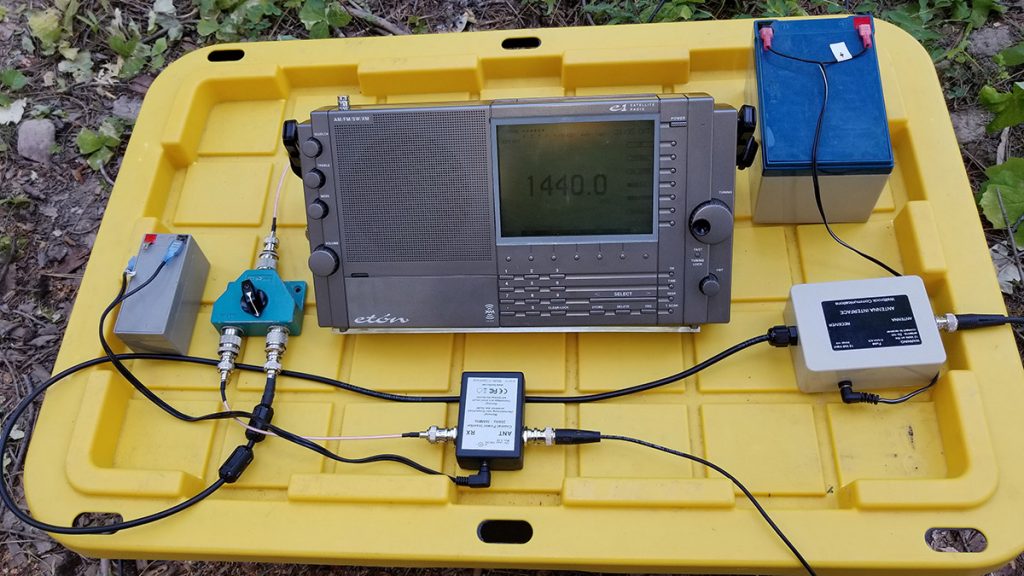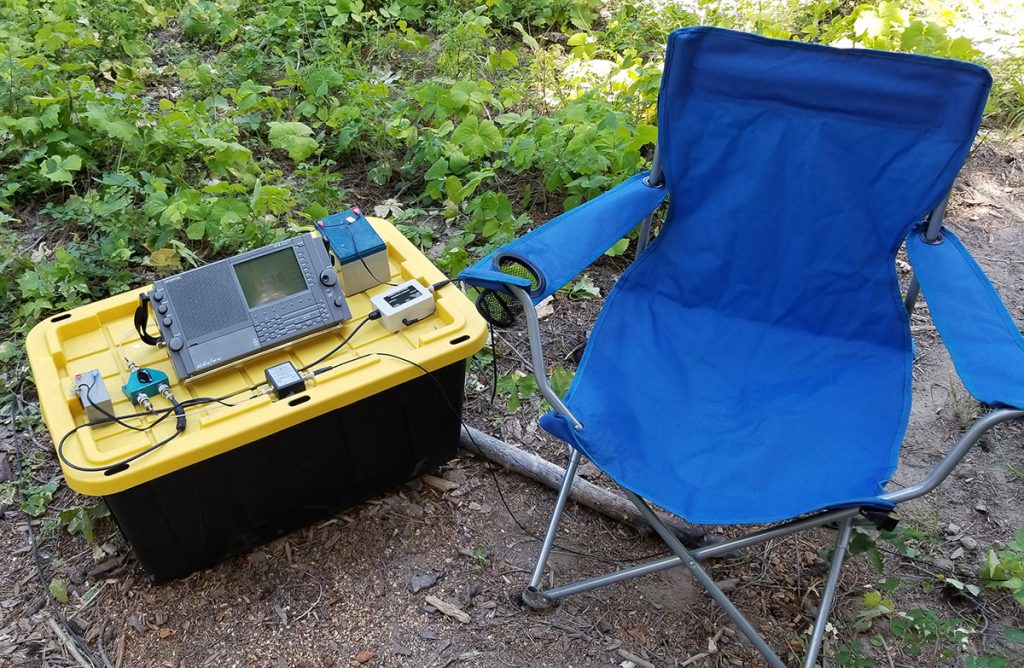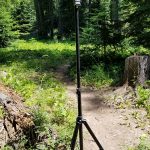One fits in a car (well, most vehicles anyway) and another easily slides into a small daypack; which antenna is best for DXing on-the-go? The ALA1530LNP and Boni Whip are at opposite ends of the portability scale (as well as the price scale).
I’ve written about the ALA1530LNP in the pages of the SWLing Post before, where I compared it against another Wellbrook loop antenna on extremely weak medium wave signals. The ALA1530LNP currently costs $413 USD including shipping to the Seattle USA area where I live.
More recently I’ve been intrigued by UK Oxford Shortwave Log’s (YouTube) excellent videos demonstrating the DXing prowess of the very compact, highly portable Bonito Boni Whip antenna. Through a Bonito USA dealer I was able to purchase the Boni Whip at an attractive $99 USD price (plus $11 shipping).
So, is it fair to compare “apples and oranges”? Maybe not, but it was fun and interesting nonetheless to take both antennas to the countryside to find out how they perform head-to-head in a portable situation. My destination was a small forested campground, in a valley east of this beautiful Mount Rainier, Washington scene:
Over the course of three days I compared the two antennas with these receivers:
- Eton E1XM
- Sangean ATS-909X
- Elad FDM-S2
I set up the E1XM and ATS-909X receivers on a portable tote box with the antennas powered by SLA gel cell batteries and using a two-way antenna switch for instant comparisons.

 Each antenna was mounted on its own “pro” speaker stand and separated 60 feet from each other. The antennas were connected to receivers by equal 100 foot lengths of RG-58 coax cable, and were over 80 feet away from my laptop computer (the only noise source in the area).
Each antenna was mounted on its own “pro” speaker stand and separated 60 feet from each other. The antennas were connected to receivers by equal 100 foot lengths of RG-58 coax cable, and were over 80 feet away from my laptop computer (the only noise source in the area).
In keeping with the uber-portable theme of the Bonito antenna, I used a very compact 1.2Ah SLA gel cell battery for its power injector (junction box). Since the antenna consumes a mere 45 ma. of current, this small rechargeable battery will power the Boni Whip for many, many hours.
The Wellbrook ALA1530LNP requires a still reasonable 200 ma., and I brought along a much larger battery to power it.
Below are a selection of 30-second medium wave and shortwave recordings, each one of them beginning with the Boni Whip and switching to the ALA1530LNP midway through the recording.
Boni Whip vs ALA1530LNP – E1XM Receiver
660 kHz
870 kHz
1660 kHz
3330 kHz, CHU Canada
4960 kHz, VOA Sao Tome
9535 kHz, R. Algerienne
11600 kHz, Denge Kurdistan
11760 kHz, R. Havana Cuba
EDIT 7/14/2017: 11905 kHz, Reach Beyond Radio, Kununurra WA Australia (tentative; listen for the Aussie-accented weather forecast at the end of the Wellbrook loop portion. This catch was at 03:48 UTC, which matches up with the brief English language broadcast in Reach Beyond’s schedule for 11905 kHz. This catch does not appear to be China National Radio as I first thought.)
Boni Whip vs ALA1530LNP – Elad FDM-S2
These 30-second videos are from the Elad SDR’s FDM-SW2 software. As above, the first half of each recording is the Bonito antenna followed by the Wellbrook loop. If you maximize the playback of a video to full screen you can read the signal-to-noise ratio (SNR) change (“Delta”) as the antenna is switched to the ALA1530LNP.
The compact Boni Whip is a unique commercial design of “mini whip” antenna, pioneered by Roelof Bakker, PA0RDT some years ago. As with all these compact e-field antennas they can be a significant “noise sponge”, collecting any RFI or interference in the area. This is especially true if the coax shield is not grounded. Despite using two Bryant/Bowers design of RF chokes in series, the Boni Whip’s reception was degraded by RFI emitted from my laptop over 80 feet from the antennas. The RFI was quite a bit worse without any RF chokes in-line. You’ll note though that even the Wellbrook loop received some interference from the laptop on the higher shortwave frequencies.
4840 kHz, WWCR, Nashville TN USA
5985 kHz, R. Taiwan Intl. via WYFR, FL USA
6090 kHz, The Caribbean Beacon, Anguilla (distorted, with transmitter problems)
9600 kHz, unidentified station
11725 kHz, R. New Zealand Intl.
11790 kHz, R. France Intl., Issoudun
11840 kHz, R. Havana Cuba (target: Chile)
Observations. On medium wave (E1XM examples) the directionality of the Wellbrook loop could be noted on one, maybe two of the three recordings. This can be a benefit–or not–depending on your goal. (I did not rotate the Wellbrook loop to null or peak any specific MW signals.) The omni-directional Boni Whip would not be the antenna of choice for a hard-core medium wave DXer; however, it is extremely compact and lightweight for camping and travel if you will be DXing or SWLing on shortwave also. The Wellbrook though is highly regarded as a medium wave DX antenna, especially when used with a rotor to take advantage of its sharp broadside nulls.
I didn’t test the Boni Whip on long wave, but Oxford Shortwave Log and others report it does very well on LF. I tried the antenna on FM frequencies against the Eton and Sangean’s telescopic whip antennas but in every case the reception was worse on the Boni Whip.
As I expected on shortwave, the ALA1530LNP greatly outperformed the Boni Whip on some signals. On others, reception was extremely comparable! The 3330 kHz CHU recording surprised me with the neck-and-neck reception. At this tropical band frequency there may have been some directionality to the signal, and the loop may not have been oriented optimally. The 4960 VOA reception was also very close.
I was disappointed, but not surprised at the RFI pickup of the Boni Whip when using my laptop and the Elad SDR receiver. The two RF chokes tamed the spikes and hash a bit, but removal was far from complete. The Wellbrook wasn’t always “clean” in this regard though.
Final notes. I think the Boni Whip is an extremely high value in a “jack of all trades” very portable antenna. Like Oxford Shortwave Log and others, I find this active antenna’s noise level to be extremely low, helping its sensitivity reveal weak DX signals in a surprising fashion. I would not hesitate to use this antenna away from noise sources when traveling with a non-computerized receiver. Well done, Bonito!
Is the Wellbrook ALA1530LNP worth four times the Boni Whip’s USA price? To the serious DXer who has no room for large passive antennas (Beverages, phased delta loops, DKAZ, etc.), the 1-meter diameter Wellbrook is clearly in a class of its own. By the way, the US Dollar to UK Pound ratio has improved in recent months, so the Wellbrook is an improved value for USA radio hobbyists now.
Truly this was an “apples to oranges” comparison, but I thoroughly enjoyed using both models. I welcome your comments, particularly if you also own both of these fine antennas.
Guy Atkins is a Sr. Graphic Designer for T-Mobile and lives near Seattle, Washington. He’s a regular contributor to the SWLing Post.


2021 update, I got the Bonito MA305 a couple of years now and getting the longer whip vs the stock whip which Bonito also supply makes a notable difference to the signal strength while also keeping SNR at an exceptionally low level, the MA305 is a superb DX Antenna for it’s size, almost unbelieveable and is especially suited for portable radios because it outputs enough signal where as a long wire can introduce too much signal level overloading the radio and with much higher noise, this is what makes the Bonito MA305 even more remarkable is the performance vs price in such a tiny package.
Mine is home use only mounted 30 feet in a tree and I have the coax grounded at the base of this tree using the spike from Bonito.
I recently got the updated version of the Russian Malahit, DSP 2 and this provides power to the Bonito which is extremely convenient meaning I don’t need the bias-t which cuts down on the amount of clutter and would be another benefit in the field.
Hi Mark, that indeed sounds like a great setup! Thanks for sharing your experiences. I’d forgotten about the availability of the longer whip antenna option. It’s good to hear it makes a difference.
Hello Guy, thank you for this very thorough test. Your results largely mirror my own experiences with these antennas. My takeaway points are:
1. The Boni Whip is a superbly designed portable antenna, offering excellent SNR performance in the field and unparalleled portability.
2. Using a an SDR with the whip (and therefore a computer) will benefit from local grounding, however, as you correctly point out, this isn’t feasible on a DXpedition; thus this antenna is best used outdoors with a portable.
3. On shortwave in particular, your set-up was slightly more sensitive with the Wellbrook, however, the performance delta is very marginal in some of your recordings. I would therefore expect hard-core DXers to be more accepting of the Wellbrook’s rather disproportionate price tag than casual listeners.
4. The noise floor on the Boni Whip – and the MegActive MA305 for that matter is very low indeed.
5. The 2nd and 3rd intercept points of the Boni Whip and MA305 are just about identical and both specify a Gain of +3 dB. The MA305 has a slightly wider bandwidth (tuning down to 9 kHz, versus 20 kHz for the Boni Whip). USB operation of the MA305 is the big value proposition of this antenna.
6. The MA305 has a 22 cm radiating element supplied as standard, versus 9 cm for the Boni Whip, but you have the flexibility to use home-brew elements if you so wish.
7. Using an E-field antenna at hight appears to help a bit – I use mine about 4 metres above ground. I don’t have anything empirical to support this as yet – that’s another experiment for another day!
8. At home, under the ubiquitous blanket of RFI, the Wellbrook offers is the most compelling performance of the two antennas, irrespective of whether the Bonito is earthed or not – unless you live in a very quiet environment.
9. In my experience, both Bonito antennas perform almost as well as a 50 metre longwire out in the field.
10.To summarise; my experience over the past two years suggests that the H-field Wellbrook is the best option at home – and for hard-core DXers. However, the Boni Whip offers near-equal performance out in the field, for about a third of the price.
Thanks again,
Clint
Thanks so much for your comments on my article, Clint! With all your experience with the Bonito antennas, your observations are highly valued. I look forward to seeing more of your videos on your YouTube channel and here in the pages of the SWLing Post.
Best wishes,
Guy
Thank you Tudor and Guy for answering.
UPDATE to the 11905 kHz (E1XM) recording caption: I discovered that the last few seconds of this audio file gives a strong clue to the station’s identity, and it’s not China National Radio as I first thought. I’m hearing weak, Aussie-accented English with weather report details at the end of the Wellbrook loop portion. The accent sounds similar to what I hear on trans-Pacific MW DX from the Washington coast. The 0348 UTC time corresponds to the 11:45-12:00 Kununurra local time of their brief English schedule on 11905. I’ve updated the article text with this information.
This discovery helps show the value of the Wellbrook loop in this situation, as I cannot ID the language at all in the Boni Whip portion of the recording.
I would like to ask if there are any differences between Boni-Whip and MegActiv MA305 apart power supply.
Hi Christos, to my knowledge the power supply is the primary difference, although the longer antenna element of the MegActiv may make a difference. I’m sure that Clint (Oxford Shortwave Log) could comment on the reception differences if he reads this.
I have both Bonito antennas and the MegActiv one seems to be better on lower frequencies.
Guy, this is a most impressive comparison! Thank you for taking the time to put these videos and audio clips together.
It goes to show how effective an antenna like the Wellbrook is when in the presence of local interference/RFI. At the same time, I can’t believe the results of the MiniWhip. It boggles the mind to think such a compromised antenna (size-wise) can achieve such impressive results. It just confirms Oxford Shortwave’s findings as well.
I’ve been testing a homebrew miniwhip design (based on the same antenna used at the U Twente WebSDR) that was built by friend/contributor, Steve Yothment. Before handing over the antenna to me he had mentioned the importance of moving it away from RFI as far as possible. While testing the antenna here at our condo in Québec, I can confirm that it certainly acts as an RFI sponge. In the field, it does an admirable job, though! And, golly, could it be more portable?
I agree with your conclusion about the Wellbrook as well: if you’re a DXer, it’s likely worth the extra cost!
Both of these antennas are worthy DXing tools. Thanks again–I know the amount of time it takes to put together a review like this. We very much appreciate it!
Thomas
SUsing the Mini-Whip without a local ground connection is misleading, as it will certainly pick up noise on the coax from the PC.
The Mimi-Whip absolutely requires a local Ground. Better still would be a local Ground and a braid-breaker balun to keep the PC noise getting to the whip..
But the worst combination would be no local ground, but with a braid beaker. That would be forcing the Mini-whip to operate completely without a Ground.
Also, because the Mini-Whip is an Electric Field antenna, it really benefits from being mounted as high as possible, and in the clear (eg away from trees)..
Hi John, you made some good comments about grounding, and for a permanent installation I would heartily agree. My comparison was to check out the suitability of the antennas in a portable, temporary installation. YouTube author Oxford Shortwave Log also uses his Bonito antennas “on the go” when proper grounding isn’t practical. Indeed, from what I’ve read, the mini whip designs use the feed line braid as a component of the system. That’s why I didn’t install chokes right at the antenna, but at the receiver end. The ground-less installation is definitely not ideal, that’s for sure.
Those recordings don’t tell us much, as all we hear is a confusing mess on both antennas. Weak BC stations on otherwise clear channels are much more revealing. Then there is the noise rejection. How well does each antenna cope with local electrical noise? In my experience in a crowded suburban area, mini whips etc pick up lots of noise from TV’s and switch-mode supplies and loops tend to suppress it.
Actually, I believe these video and audio clips are quite telling–a brilliant example of how effectively magnetic loop antennas reject local noise.
If you expand the videos to full screen, simply watching the FDM-S2 waterfall display will tell you much. As the antennas are switched, watch the waterfall background color change–this directly reflects the change in noise.
Guy was very thorough to test both an SDR and a portable. Most impressive!